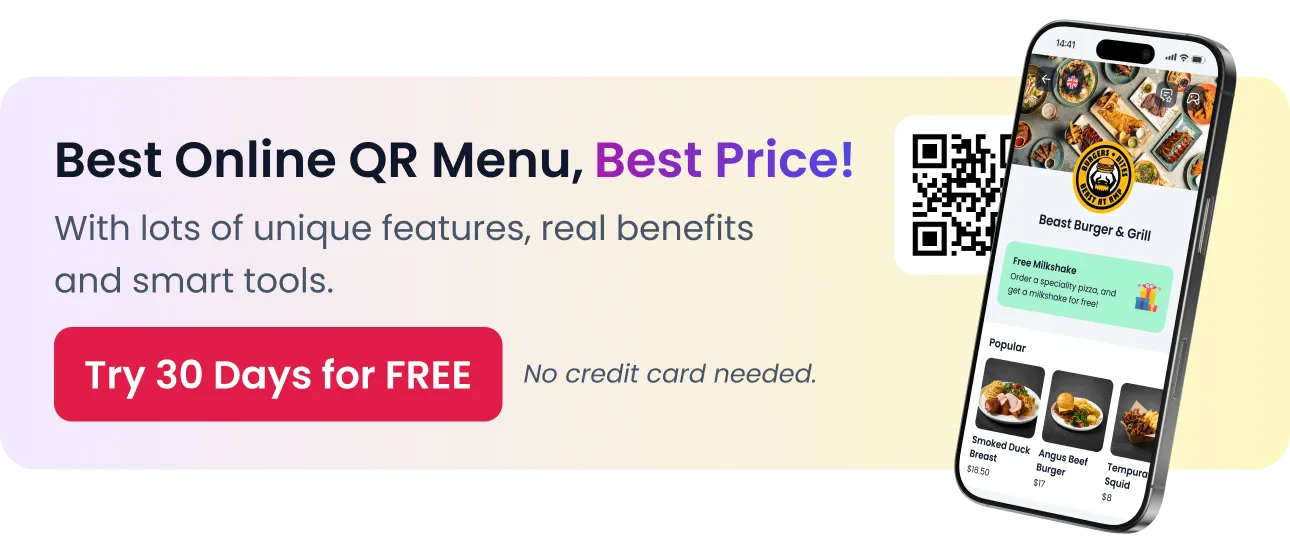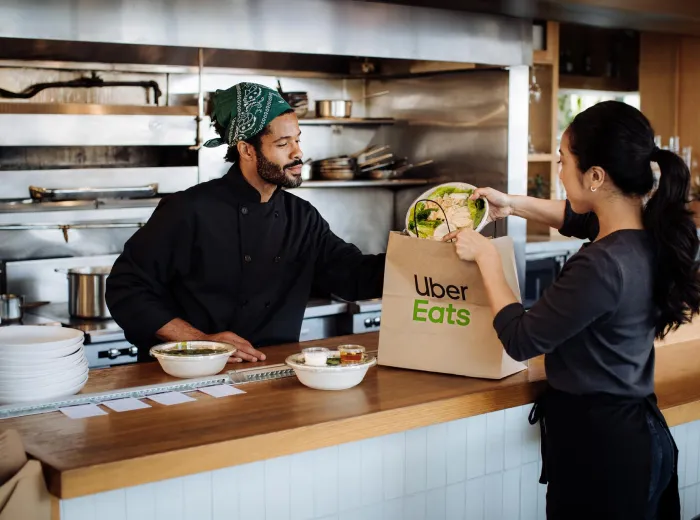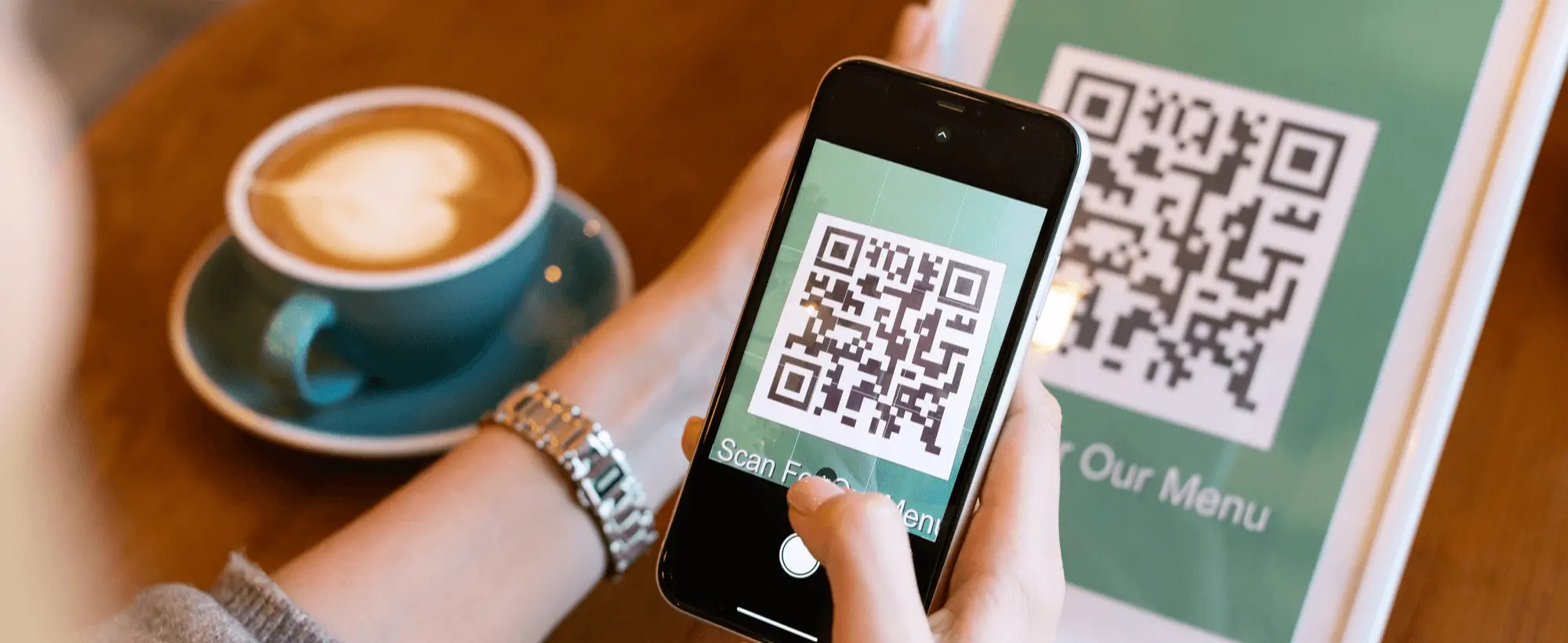
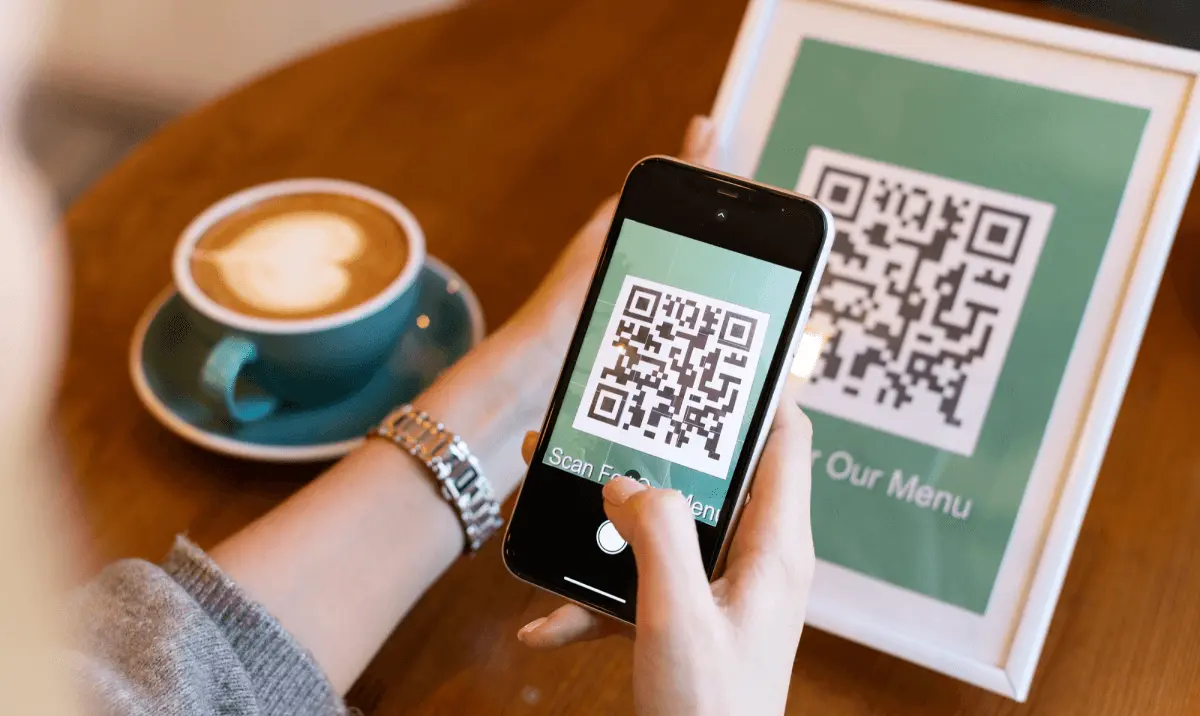
Are QR Code Menus Useful for Restaurants?
In the fast-evolving landscape of the restaurant industry, technology has played a crucial role in adapting to new consumer demands. Among these innovations, QR code menus have emerged as a powerful tool, revolutionizing the way customers interact with restaurants. Initially popularized as a safety measure during the global pandemic, QR code menus have now become more than just a trend—they offer long-term benefits that cater to the digital-first generation of consumers.
But are QR code menus truly as beneficial as they seem? Restaurants, cafes, and bars of all sizes are grappling with this question as they weigh the pros and cons of going fully digital. With promises of improved efficiency, reduced costs, and enhanced customer engagement, QR code menus could be a game-changer. However, these digital solutions also come with their own set of challenges, such as accessibility concerns and technology limitations.
In this article, we’ll dive deep into the benefits, challenges, and long-term impact of QR code menus on restaurants, providing you with a comprehensive guide to decide if they’re the right fit for your establishment.
Would you like to listen our deep-dive conversation about this article?
What is a QR Code Menu?
QR code menus are quickly becoming a standard feature in many restaurants, cafes, and bars, especially in the post-pandemic era. But what exactly are they, and how do they work? QR code menus are essentially digital versions of traditional menus, accessible via smartphones by scanning a quick response (QR) code. Below, we’ll break down their definition, how they function, and popular providers that can help you implement this technology in your establishment.
Definition of a QR Code Menu
A QR code menu is a digital menu that customers access by scanning a QR code with their smartphone camera or a QR scanning app. The code typically directs them to a webpage or PDF where they can view the restaurant’s menu items, often with photos and detailed descriptions.
Key elements include:
- Digital Accessibility: Accessible via smartphones or tablets.
- Customizable Content: Restaurants can update menu items in real-time.
- Interactive Elements: Some QR code menus allow customers to place orders directly from their devices.
How QR Code Menus Work in Restaurants
When customers sit down at a table, they can scan the QR code placed on their table, receipt, or even wall posters. The scanned code redirects them to a webpage containing the restaurant’s menu, and in some cases, they can even place orders or pay directly through this platform.
Steps for using a QR code menu:
- Scan the QR code: Customers point their smartphone camera at the code.
- Access the digital menu: The QR code opens the restaurant’s online menu.
- Browse and select: Customers can explore the menu and, in some cases, place their order directly through the menu interface.
Popular QR Code Menu Providers
There are several QR code menu platforms available, each offering unique features. Some are standalone providers, while others integrate directly with existing point-of-sale (POS) systems. Popular providers include:
- Menuviel: Known for offering pre-made dietary and allergen badges, allowing restaurants to easily customize their digital menus.
- Beaconstac: Provides a fully customizable QR code menu solution with advanced tracking features.
- Square: A comprehensive platform that integrates QR code menus with payment systems, making it easy for customers to browse, order, and pay.
- GoTab: Focuses on both QR code menus and mobile ordering, allowing for seamless integration into restaurant operations.
Choosing the right provider depends on your restaurant’s specific needs, such as order management, real-time updates, and customer interaction preferences.
The Benefits of Using QR Code Menus
As restaurants continue to adapt to changing customer expectations and industry trends, QR code menus offer several advantages that can boost efficiency, customer satisfaction, and cost savings. This digital solution not only enhances the dining experience but also aligns with modern sustainability goals. Below, we explore the most impactful benefits of implementing QR code menus in your restaurant.
Contactless Ordering for Health & Safety
One of the primary reasons for the rise of QR code menus was the need for contactless interactions, especially during the pandemic. This method allows customers to view the menu and even place orders without needing to handle physical menus, thus reducing the risk of spreading germs.
Key benefits include:
- No physical contact required, offering a safer dining experience.
- Improved hygiene, as traditional menus can harbor bacteria.
- Appeals to health-conscious diners, especially in crowded or high-turnover restaurants.
Faster and More Efficient Service
With QR code menus, restaurants can streamline operations, leading to quicker service and improved customer satisfaction. When customers can view the menu, place their order, and even pay directly from their phones, it reduces the time staff need to spend on these tasks.
Advantages of faster service:
- Reduced wait times for customers to place orders.
- Staff focus shifts from order-taking to food preparation and customer service.
- Fewer mistakes as customers input their own orders directly into the system.
Cost Savings on Printing Menus
Traditional printed menus can become a significant ongoing expense, especially when items or prices change frequently. QR code menus eliminate the need for reprints, saving both money and time in the long run.
Benefits of cutting printing costs:
- No need for constant reprinting of menus due to seasonal changes or pricing updates.
- Lower paper and ink costs, contributing to operational savings.
- Time saved, as there’s no need to redesign and order new menus every time an update is required.
Real-Time Menu Updates and Flexibility
QR code menus provide the flexibility to make real-time changes to your menu, such as updating prices, adding new dishes, or removing out-of-stock items without any delay. This agility ensures that customers always see the most up-to-date offerings.
Advantages of real-time updates:
- Instant updates to menu items and pricing without delay.
- Easy to promote specials or limited-time offers in real-time.
- Consistency across all locations, if you manage multiple branches.
Reducing Environmental Impact
Going digital with QR code menus can significantly reduce your restaurant’s environmental footprint. By eliminating printed menus, you can save on paper waste and ink consumption, contributing to a more sustainable operation.
Key environmental benefits:
- Reduction in paper waste by cutting out disposable menus.
- Less ink and chemical use, which is better for the environment.
- Aligning with eco-friendly consumer preferences, which is increasingly important to today’s diners.
These key benefits show how QR code menus can improve not just the operational efficiency of your restaurant but also enhance the overall dining experience while supporting sustainability goals.
How QR Code Menus Enhance Customer Experience
QR code menus do more than just improve operational efficiency—they also significantly enhance the customer experience. By offering convenience, personalization, and engagement, QR code menus cater to the expectations of modern diners, many of whom seek seamless and interactive experiences. Let’s explore how QR code menus can transform the way customers interact with your restaurant.
Interactive and Visual Menus
Unlike traditional paper menus, QR code menus offer dynamic and visually engaging content. Restaurants can incorporate high-quality images, videos, and descriptions, making the menu more appealing and informative for customers.
Benefits of interactive menus:
- High-quality images help customers visualize dishes.
- Videos and descriptions can introduce new or unfamiliar menu items.
- Clickable elements like add-ons and modifications enhance interactivity.
Personalization Options and Dietary Preferences
QR code menus can be customized to cater to individual customer preferences, such as dietary restrictions, allergens, or even previous order history. This personalization not only adds value but also shows customers that your restaurant cares about their specific needs.
How QR code menus personalize experiences:
- Dietary filters allow customers to view only vegan, gluten-free, or other specific dishes.
- Allergen badges, like those offered by Menuviel, help diners make informed choices.
- Customer history integration, where repeat visitors can see their favorite dishes or previous orders.
Multilingual Menus for a Diverse Audience
For restaurants in tourist-heavy areas or those that serve a diverse customer base, QR code menus can easily be translated into multiple languages, offering an inclusive dining experience for all patrons.
Advantages of multilingual menus:
- Enhanced accessibility for non-native speakers.
- Improved customer satisfaction as diners feel more comfortable ordering.
- A broader reach, particularly in international or diverse markets.
Increasing Customer Engagement with Offers & Loyalty Programs
QR code menus provide an excellent opportunity for engaging customers beyond just ordering food. Restaurants can integrate loyalty programs, special offers, or personalized promotions directly within the digital menu, encouraging repeat visits and boosting customer loyalty.
Ways to increase engagement:
- Embedded promotions, such as “order this dish and get 10% off.”
- Loyalty points tracking, where customers can see their rewards and upcoming milestones.
- Exclusive offers for customers who use the QR code menu frequently, incentivizing future visits.
By providing interactive, personalized, and engaging experiences, QR code menus not only make dining more enjoyable for customers but also foster stronger connections between diners and restaurants. These enhanced experiences can lead to increased satisfaction, loyalty, and even repeat business.
Potential Challenges of QR Code Menus
While QR code menus offer numerous benefits, they are not without their challenges. Implementing and maintaining these digital tools can present certain obstacles for both customers and restaurant operators. From accessibility concerns to technology limitations, understanding these potential challenges is crucial to ensuring a smooth and effective experience.
Customer Tech-Savviness and Accessibility Issues
Not all customers are comfortable with or have access to the technology required to use QR code menus. Some diners, particularly older generations, may struggle with scanning codes or navigating digital menus.
Challenges related to tech-savviness:
- Not all customers have smartphones capable of scanning QR codes.
- Lack of familiarity with scanning QR codes and using digital platforms.
- Difficulty navigating menus on smaller smartphone screens.
Device Dependency: What If Customers Don’t Have Smartphones?
Relying on customers to have smartphones can pose a problem, as not everyone will have a compatible device. Some may also prefer the tactile experience of a physical menu or may not want to use their phone while dining.
Key device dependency issues:
- Smartphone unavailability, especially for older diners or those with broken devices.
- Customers prefer traditional menus, especially for a more relaxed dining experience.
- Battery and connectivity issues, which can render QR code menus unusable.
Internet Connectivity Problems
QR code menus require stable internet connectivity for seamless access. If your restaurant or customers face poor Wi-Fi or mobile data coverage, this could frustrate diners and lead to a negative experience.
Connectivity-related challenges:
- Unreliable Wi-Fi in restaurants can prevent access to the menu.
- Mobile data limitations for customers in areas with poor reception.
- Interruptions in service, particularly during peak hours, leading to delays in ordering.
Data Security and Privacy Concerns
Using digital platforms to access menus may raise privacy concerns for some customers. The collection of personal data, including phone numbers or browsing behavior, can make diners uncomfortable, especially if data security measures are not transparent.
Data security risks:
- Concerns over data collection, such as tracking customer preferences and browsing behavior.
- Potential hacking risks or misuse of personal data if systems aren’t secure.
- Lack of transparency regarding how customer data is stored or used.
While QR code menus offer a modern solution, it’s essential to acknowledge and address these challenges. Restaurants must be prepared to offer alternatives, like physical menus, and invest in technology that ensures both a secure and accessible experience for all diners.
How to Successfully Implement QR Code Menus
Introducing QR code menus into your restaurant can streamline operations and improve customer experiences, but a smooth implementation is key to their success. Proper planning, staff training, and menu design are essential to ensure that both your team and customers can easily adapt to this technology. In this section, we’ll explore the steps and best practices for effectively launching QR code menus in your establishment.
Best Practices for a Smooth Transition
A successful shift to QR code menus requires more than just printing codes and placing them on tables. By following these best practices, you can ensure a seamless transition that minimizes disruption and maximizes customer satisfaction.
Key best practices include:
- Offer both options (digital and printed) during the transition period to accommodate all customers.
- Place QR codes strategically in visible and accessible locations such as tables, counters, and receipts.
- Clearly communicate the change to customers using signage and staff guidance.
Training Staff for QR Code Menu Usage
For QR code menus to be effective, your staff needs to be comfortable with the technology and able to assist customers. Proper training ensures that your team can troubleshoot common issues and provide a high level of service.
Staff training tips:
- Educate staff on how QR code menus work, including how to assist customers in scanning and navigating the digital menu.
- Troubleshooting common problems, such as QR codes not scanning or connectivity issues.
- Train staff on alternative solutions, such as providing printed menus for those who prefer them.
Designing User-Friendly QR Code Menus
A well-designed QR code menu should be easy to navigate and visually appealing. Focus on simplicity and clarity to ensure that customers can quickly find what they are looking for without frustration.
Elements of a user-friendly QR code menu:
- Organize menu sections clearly with intuitive navigation, such as categorizing appetizers, main courses, and beverages.
- Use high-quality images of dishes to enhance visual appeal and help customers make decisions.
- Include allergen and dietary information, using symbols or badges for easy identification.
Integrating QR Code Menus with POS Systems
To maximize efficiency, integrating your QR code menu with your point-of-sale (POS) system can streamline the ordering process. This integration allows customers to place orders directly from their phones, which syncs with the kitchen and billing systems.
Advantages of POS integration:
- Automatic order processing, reducing human error and speeding up service.
- Streamlined payments, allowing customers to pay directly through the digital menu.
- Real-time updates to menu items, so out-of-stock dishes are automatically hidden from the menu.
By following these steps, you can successfully implement QR code menus in your restaurant, enhancing both customer convenience and operational efficiency. With proper planning and execution, this technology can lead to smoother service and a more modern dining experience.
QR Code Menus vs Traditional Menus
The debate between QR code menus and traditional printed menus has gained traction as more restaurants embrace digital solutions. Both options have their unique benefits and drawbacks, and understanding these differences is crucial for deciding which menu format best suits your restaurant’s needs. In this section, we’ll explore how QR code menus stack up against traditional menus in terms of cost, adaptability, customer preferences, and more.
Comparing Costs: Long-Term Savings vs Initial Setup
While traditional menus incur ongoing printing costs, QR code menus require an initial investment in digital infrastructure. However, the long-term savings from eliminating frequent reprints can outweigh the upfront expenses of QR code menu systems.
Cost comparison:
- Traditional menus: Frequent reprints due to menu changes, wear and tear, or seasonal updates.
- QR code menus: One-time setup cost with lower long-term maintenance, as updates are done digitally.
- Savings potential: QR code menus can save on printing and design fees over time.
Adaptability: Real-Time Changes vs Fixed Menus
One of the significant advantages of QR code menus is their flexibility. With a digital platform, you can make real-time updates to your menu, such as changing prices, adding seasonal items, or removing sold-out dishes. In contrast, traditional menus require reprinting for every change, which can be time-consuming and costly.
Adaptability benefits:
- QR code menus: Instant updates to pricing, items, and promotions.
- Traditional menus: Changes require reprints, leading to delays and added costs.
- Flexibility advantage: QR code menus offer greater responsiveness to inventory changes and customer feedback.
Customer Preferences: Digital Experience vs Tangibility
Customer preferences play a key role in deciding which menu format to use. While many customers enjoy the convenience and interactivity of digital menus, some still prefer the tactile experience of holding a traditional menu. Offering both options can cater to diverse customer needs.
Comparing customer preferences:
- QR code menus: Appeal to tech-savvy diners and younger generations looking for convenience and interactivity.
- Traditional menus: Preferred by customers who enjoy the tangible feel of a printed menu and the social experience of ordering without technology.
- Hybrid approach: Offering both digital and printed menus can accommodate a wider audience and create a more inclusive dining experience.
Hybrid Solutions: Offering Both Options for Diverse Audiences
For restaurants unsure whether to fully switch to QR code menus, a hybrid approach can be the best of both worlds. Offering both digital and printed menus ensures that all customers, regardless of preference or technology access, can enjoy their dining experience.
Benefits of a hybrid approach:
- Appeal to tech and non-tech users, providing flexibility and choice.
- Easy transitions during peak times, as customers can choose their preferred method.
- Increased customer satisfaction, as diners feel more comfortable and accommodated.
The choice between QR code menus and traditional menus doesn’t have to be an either/or decision. By understanding the strengths and limitations of each option, restaurants can tailor their approach to meet both operational needs and customer preferences, potentially combining the two for a more versatile dining experience.
How to Promote Your QR Code Menu to Customers
Introducing a QR code menu to your restaurant is a great step, but to ensure its success, you need to effectively promote it to your customers. Many diners may be unfamiliar with how QR code menus work, or they may need encouragement to transition from traditional menus. With the right marketing and promotional tactics, you can boost customer awareness and adoption of your digital menu. Here are the key strategies to promote your QR code menu and encourage its use.
Placing QR Codes Strategically in Your Restaurant
Where you place your QR codes matters. To maximize visibility and usage, it’s important to position them in high-traffic and easily accessible areas of your restaurant.
Best placement strategies:
- On tables: Place a QR code stand or sticker on each table, ensuring it’s within easy reach of customers.
- At the entrance: Display QR codes at the front door so customers can browse the menu while waiting to be seated.
- On receipts: Include QR codes on receipts, allowing customers to re-access the menu for future visits or order from your website.
- On takeout containers: Promote your digital menu by placing QR codes on takeout packaging, encouraging repeat customers to check out your offerings from home.
Marketing QR Code Menus on Social Media
Your online presence is an excellent platform for promoting your QR code menu. Using your restaurant’s social media accounts, you can generate excitement around the convenience and features of your digital menu.
Social media strategies for promoting QR code menus:
- Post tutorials or videos on how easy it is to scan and use your QR code menu.
- Highlight special offers or discounts for customers who use the QR code to place their orders.
- Use Instagram Stories or Facebook posts to showcase your digital menu’s interactivity and visual appeal.
- Share customer experiences by encouraging diners to post photos of their meals and tag your restaurant when using the QR code menu.
Encouraging Repeat Use with Incentives
To motivate customers to adopt your QR code menu, offering incentives can make a big difference. Whether it’s a discount or loyalty rewards, these incentives can drive engagement and repeat use of your digital menu.
Ways to encourage repeat use:
- Offer discounts for first-time users who scan the QR code to access the menu.
- Loyalty program integration, where customers can earn points or rewards by using the QR code menu regularly.
- Limited-time promotions exclusively for QR code users, such as “scan the QR code to receive 10% off your next visit.”
- Gamify the experience by offering customers a chance to win prizes or discounts when they use the QR code menu for ordering.
By strategically placing QR codes, marketing them on social media, and providing enticing incentives, you can effectively promote your QR code menu to customers. These efforts will encourage adoption and enhance the overall dining experience, making the transition to digital menus smooth and appealing for all.
Are QR Code Menus Here to Stay?
As the restaurant industry rapidly evolves, one question remains—are QR code menus a temporary solution, or are they here to stay? While initially adopted out of necessity during the pandemic, QR code menus have demonstrated lasting value in streamlining operations and enhancing customer experiences. In this section, we’ll explore the future of QR code menus and whether they will continue to be a staple in the dining industry.
Future Trends in Restaurant Technology
The restaurant industry is constantly adopting new technologies to meet changing consumer expectations. QR code menus are part of a broader movement toward digitization, with restaurants embracing everything from mobile ordering to AI-driven personalization. As the industry moves forward, QR code menus are likely to evolve and integrate more advanced features.
Emerging trends:
- Increased personalization through integration with customer data, allowing for tailored menu suggestions.
- Enhanced mobile payment options, enabling seamless checkout experiences.
- Integration with AI to offer real-time recommendations based on customer preferences and previous orders.
Will QR Code Menus Replace Traditional Menus Completely?
While QR code menus offer numerous benefits, it’s unlikely that they will completely replace traditional menus in the near future. Customer preferences vary, and some diners still prefer the tactile experience of a physical menu. Offering both options can ensure that restaurants cater to a wider audience while still embracing modern technology.
Factors to consider:
- Diverse customer preferences, with some diners preferring the convenience of digital menus while others enjoy the familiarity of printed menus.
- Hybrid models, where restaurants offer both QR code menus and traditional printed menus to accommodate different demographics.
- Cultural differences, as some regions may adopt digital menus faster than others based on technological infrastructure and customer behavior.
Adapting to Evolving Customer Expectations
Customer expectations are constantly shifting, particularly as new generations of diners who are comfortable with technology enter the market. QR code menus offer the flexibility and convenience that today’s tech-savvy customers appreciate. As these expectations continue to evolve, restaurants that adopt and innovate with QR code menus are likely to stay ahead of the curve.
How restaurants can adapt:
- Keep pace with technology, ensuring that your QR code menu platform is user-friendly, responsive, and compatible with various devices.
- Regularly update digital menus to offer fresh, seasonal items and maintain engagement with repeat customers.
- Incorporate customer feedback to improve the digital experience and ensure it aligns with their expectations.
While QR code menus may not entirely replace traditional menus, they are certainly here to stay as an essential tool in the modern restaurant landscape. As technology advances and customer expectations shift, QR code menus will continue to evolve, offering restaurants the flexibility to meet the needs of both tech-savvy and traditional diners alike.
QR code menus have proven to be a valuable asset for modern restaurants, offering numerous benefits such as improved efficiency, cost savings, and enhanced customer experiences. While there are challenges to address, such as accessibility and technology reliance, the flexibility and long-term advantages of QR code menus make them an attractive option for many establishments. Whether you choose to fully adopt this digital solution or implement a hybrid model, embracing QR code menus can help your restaurant stay competitive, meet evolving customer expectations, and streamline operations for the future. As the industry continues to innovate, it’s clear that QR code menus are more than just a passing trend—they are shaping the future of dining.
Key Takeaways
- Enhanced Customer Experience: QR code menus provide interactive, personalized, and visually appealing digital menus, improving customer satisfaction.
- Cost and Efficiency Benefits: Switching to QR code menus reduces the need for constant reprinting and allows for real-time updates, cutting costs and improving operational efficiency.
- Health & Safety: QR code menus offer a contactless ordering solution, addressing health concerns and promoting better hygiene in restaurants.
- Challenges Exist: While QR code menus have clear benefits, potential drawbacks like customer tech-savviness, device dependency, and privacy concerns must be considered.
- Hybrid Model for Flexibility: Offering both QR code and traditional menus can cater to diverse customer preferences, ensuring no segment is left out.
- Long-Term Impact: QR code menus are likely here to stay, adapting with future trends in restaurant technology and evolving customer expectations.
ABOUT THE AUTHOR
Erkin Coban
Your Customers Deserve The Best
And we got Menuviel for them.
The fastest and easy-to-use online QR menu with 12+ unique features. Choose Menuviel and elevate your service quality to the next level.
Use free for the first 30 days.
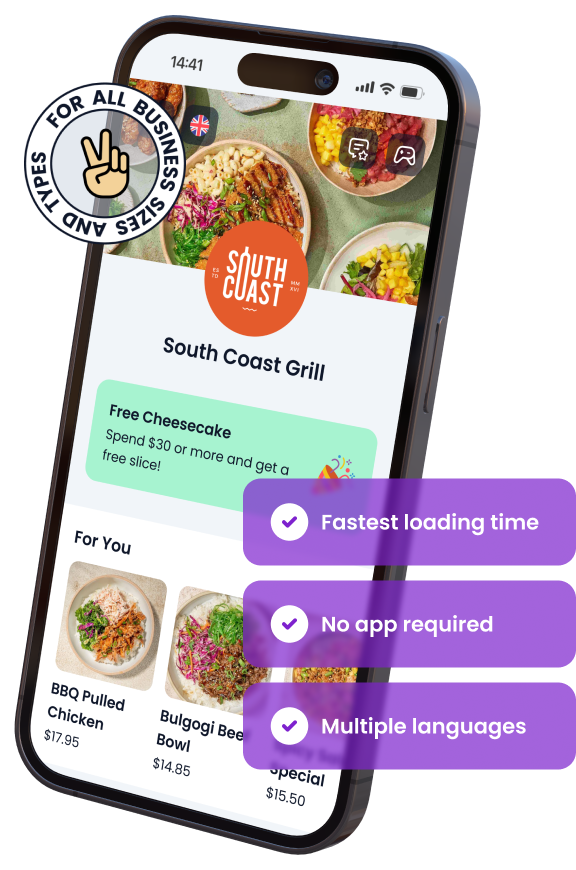
In This Article

Free AI Tools for Restaurants
TRY NOW ➜

Lightning-fast loading pages and images
Your menu loads instantly with optimized images—no waiting, just a smooth browsing experience.




